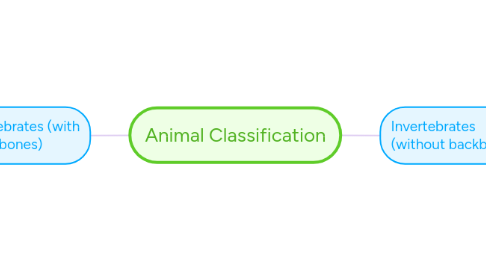
1. Vertebrates (with backbones)
1.1. Endothermic (warm-blooded)
1.1.1. Mammals
1.1.1.1. Have fur or hair.
1.1.1.2. Produce milk to feed their babies.
1.1.2. Birds
1.1.2.1. Have feathers, wings, and beaks.
1.1.2.2. Lay eggs with hard, waterproof shells.
1.2. Ectothermic (cold-blooded)
1.2.1. Fish
1.2.1.1. Have scales on their bodies.
1.2.1.2. Have gills for breathing.
1.2.2. Reptiles
1.2.2.1. Are covered with scales.
1.2.2.2. Have lungs for breathing.
1.2.2.3. Lay eggs on dry land.
1.2.3. Amphibians
1.2.3.1. Breathe through their skin.
1.2.3.2. Go through metamorphosis.
1.2.3.3. Have moist slimy skin.
1.2.3.4. Lay eggs in water.
2. Invertebrates (without backbones)
2.1. Protozoa
2.1.1. Microscopic, single cell organisms.
2.2. Coelenterates
2.2.1. Soft bodies.
2.2.2. Stinging cells.
2.3. Flatworms
2.3.1. Simple and soft bodied.
2.4. Annelid Worms
2.4.1. Segmented bodies.
2.5. Arthropods
2.5.1. Arachnids
2.5.1.1. Have no antennae and eight legs.
2.5.1.2. Two body parts.
2.5.2. Crustaceans
2.5.2.1. Mostly sea creatures.
2.5.2.2. Two sets of antennae and many legs.
2.5.3. Insects
2.5.3.1. Have a hard exoskeleton on the outside of the body.
2.5.3.2. Have a body divided into three parts: the head, the thorax, and the abdomen.
2.5.3.3. Have two antennae and six legs.
2.5.3.4. Hatch from eggs.
2.5.3.5. Some have wings and some don't.
2.5.4. Myriapods
2.5.4.1. Many legs and body segments.
2.6. Mollusks
2.6.1. Soft bodied.
2.6.2. Most have shells.
2.7. Echinoderms
2.7.1. Spiny sea creatures.

